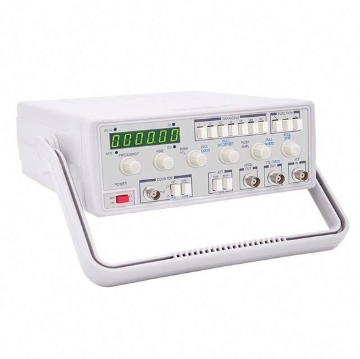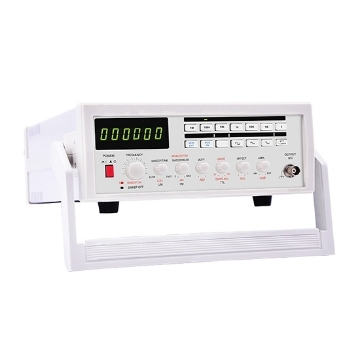Function Generators
5/10 MHz Function Signal Generator
SISCO-FSG-30
Best function generator for sale online. It is a function signal generator with a frequency range 0.1Hz~2MHz/5MHz/10MHz/13MHz/15MHz and 1Hz~30MHz frequency counter. Digital function signal generators can directly generate a sine wave, triangle wave, square wave, ramp wave, pulse wave, and sawtooth wave, used in production testing, instrument maintenance and laboratories.
$376.77
Sweep/FM Function Signal Generator, 0.1Hz~5MHz
SISCO-FSG-80
Durable function signal generators with a built-in 0.1Hz-30MHz frequency counter, can modulate AM/AF internally and externally and have linear and logarithmic frequency sweep functions, 0.1Hz~2MHz/3MHz/5MHz frequency range. Sweep/FM function signal generator can output 7 waveforms including sine wave, square wave, triangle wave and ramp wave and others.
$569.72
Audio Function Generator, 20HZ~20kHz
SISCO-AFG-RK1212BLN
The SISCO audio function generator that operates in the 20Hz to 20kHz range is a versatile tool for generating audio signals across the entire human hearing spectrum. It uses an advanced voltage-controlled oscillation circuit to produce stable, low-distortion sine wave signals.
$258.62
SISCO function generator is an electronic test equipment that can generate sine wave, square wave, triangle wave, sawtooth wave, and even arbitrary waveform. The provided function generator is a function signal generator for testing and instrument maintenance of communication, instrumentation and automatic control systems, and is also widely used in other non-electrical measurement fields. Digital function signal generator is available with a frequency sweep, AM and AF functions and 0.1Hz~2MHz/5MHz/10MHz/13MHz/15MHz frequency range.
Key Features of Function Generators
- Waveform Generation: They can generate various waveforms such as sine, square, triangle, sawtooth, and pulse waves. Different waveforms are suitable for testing different types of circuits and applications.
- Frequency Range: Function generators can produce signals across a wide frequency range, from a few hertz to several megahertz or higher, making them versatile for various electronic equipment testing.
- Amplitude and Offset Control: Users can adjust the output signal amplitude and add a DC offset, allowing the signal to meet the requirements of different circuits.
- Modulation Capabilities: Some function generators support amplitude modulation (AM), frequency modulation (FM), and pulse-width modulation (PWM) for more complex signal simulations.
Working Principle of Function Generators
- Oscillator Circuit: The core of a function generator is an oscillator circuit, typically based on a Wien bridge oscillator or a direct digital synthesis (DDS) method. The oscillator generates a stable frequency that can be adjusted over a wide range.
- Waveform Shaping: The generated frequency is then passed through waveform shaping circuits that modify the signal into different waveforms. For instance, a sine wave can be shaped into a square wave using a comparator or a triangular wave using an integrator circuit.
- Frequency and Amplitude Control: The output frequency and amplitude can be varied using control knobs or digital controls, allowing users to set the desired signal characteristics.
- Output Buffering: The shaped waveform is sent through an output buffer, ensuring it has sufficient power to drive external circuits or devices without distortion.
Applications of Function Generators
- Circuit Testing: Used to simulate signals encountered in real-world conditions.
- Education: Commonly used in teaching electronics to demonstrate signal behavior.
- Audio Testing: Used to test audio circuits and speakers by generating sound waveforms.
- Communication Systems: For testing and developing modulation schemes and receivers.
- Microcontroller and Embedded Systems: Used for testing digital logic circuits and microcontroller input/outputs.




